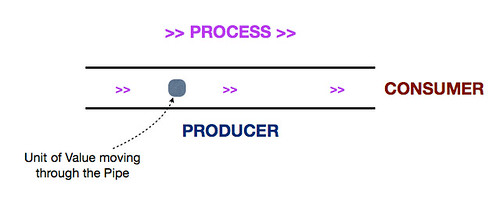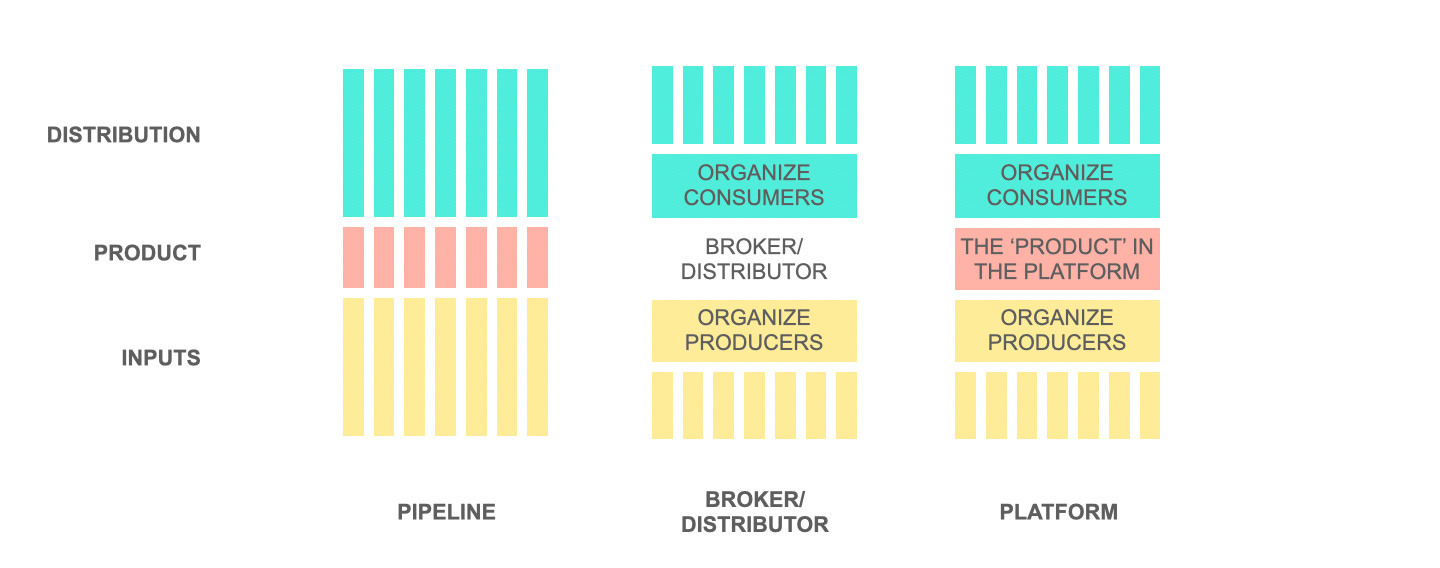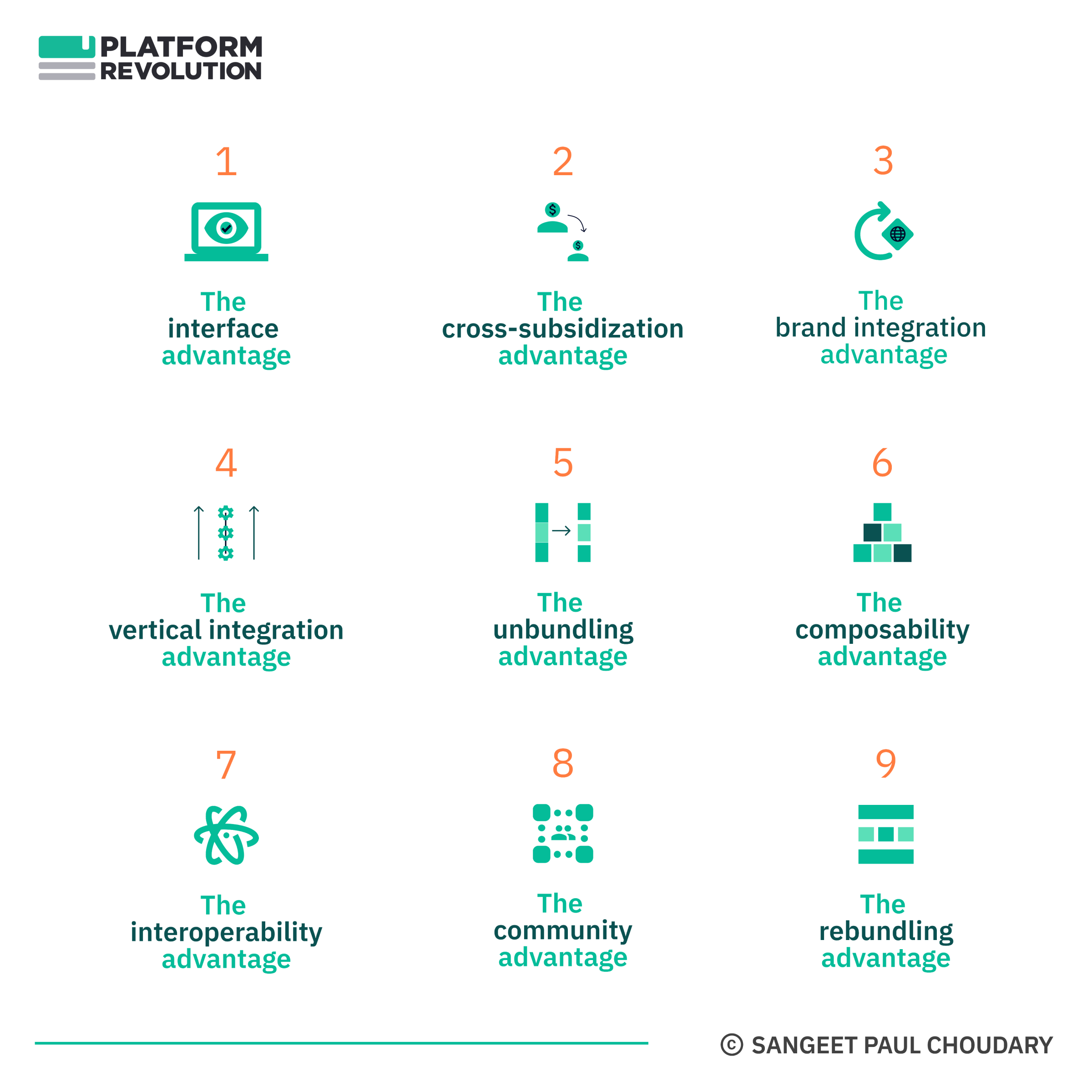Strategy
Platform design: The three elements for designing platforms
From Pipes to Platforms: Understanding the Shift in Value Creation
What does the traditional world of manufacturing have in common with the way networked platforms work? How can a basic understanding of factory design help us change the way we think about designing internet platforms, marketplaces, and social networks?
I’ve written previously about the distinction between pipes and platforms. If you haven’t already read it, you must definitely check it out. It lays out many of the basic principles that underlie the strategies I discuss in my work.
The fundamental shift, I believe, the world has seen, is the move from linearity to networks. Putting 3D printers and other recent maker movement trends aside, factory-based manufacturing has traditionally remained the same. And that’s what I refer to as Pipes, as captured by the graphic below:

Pipes are characterized by the firm as the producer and a linear flow of value.
In contrast, Platform Thinking allows for users as co-producers. Value doesn’t flow linearly from a firm to the consumer. Producers and consumers are connected with each other over a network. The platform’s role, unlike a Pipe’s, isn’t production. The platform connects producers and consumers over a network and provides them the tools to interact with each other. It then uses data to match them with each other.
Let’s dig deeper into this topic!
What is platform design?
Platform design involves a spectrum of design choices regarding the infrastructural capabilities and governance mechanisms employed by a platform. These choices are made within the framework of the market within which the platform operates, the interactions that market participants engage in, and the incentives needed to attract participation.
Platforms compete with each other not on the strength of a superior feature set or a larger user base, but on the basis of their ability to enable interactions sustainably. These interactions lie at the core of value creation. Facebook and Twitter repeatedly enable interactions between content creators and content consumers. Alibaba scales by enabling economic interactions amongst its ecosystem of sellers and buyers.

Learn More About the Platform Design Offerings
An approach to platform design should be centered around the key objective of enabling interactions in the platform’s ecosystem
Platform Design – Principles and Guidelines
The following are a core set of principles and guidelines involved in platform design:
- A platform must cater to multiple user bases, each of which may perform one or more roles in the system. It needs to balance value, costs, experience, and incentives across all these user bases and roles. Failing to achieve this balance for one user base often leads to failure of the overall platform.
- Platforms are open systems that allow users to contribute and add value. They need to ensure that users participate regularly on the platform to ensure a vibrant cycle of value creation.
- The open and frictionless nature of a platform leads to conflicting priorities. Being open and frictionless, platforms invite abundance. YouTube’s content and eBay’s listings speak of abundance. To deliver a good customer experience, it is important to ensure that a platform offers quality and relevance to ensure that the abundance does not overwhelm consumers. This priority is in conflict with being open and participative and needs to be carefully architected.
- Since users create all the value, a platform often starts with no value. Platform design decisions are critical to ensure that platforms attract usage, even at a low value.
Understanding business design: Pipeline design
Let’s look at business design at a very high level. At a fairly abstract, stratospheric level, the goal of business is the creation of value and the capture of some part of it to generate a profit. If we get back to Pipe Thinking and take the example of manufacturing, value is created in a factory or on an assembly-line. The factory’s goal is value creation.
The factory does this by setting up a set of value-creating actions – a production system – that add value to the product.
There is an end-to-end process that is responsible for value creation.
But here’s the most important, yet obvious, bit. There is a unit of production and consumption which moves through these processes AND gathers the value that is added to it by the factory. Finally, in the hands of the consumer, this unit delivers value to the consumer.
We call it the product, the object that is manufactured in a plant. It’s the car running through Toyota’s assembly line or toothpaste tube getting filled out at Colgate-Palmolive.
This object is the basic unit of production and consumption in the industrial world.
So if we think of it, the design of a manufacturing plant goes about in the following manner:
- Start with the object you’re creating; the product.
- Lay out the steps required to create it (value-creating actions)
- Design the process that encapsulates this flow of action
- Design the factory (and organization) that can execute this process.
The factory design enables the process.
The process design enables value creation.
But all of this starts with first looking at the unit that is being created, determining what value needs to be created on it and designing the entire business in a way to facilitate that value creation.
Understanding business design: Platform design
Business design, as we just noted, doesn’t start with the factory, it starts with the unit that is produced. Unfortunately, in the design of a lot of platform models, we see the design process start with the factory i.e. the website or the app. That, instead, should be the last step in the design phase.
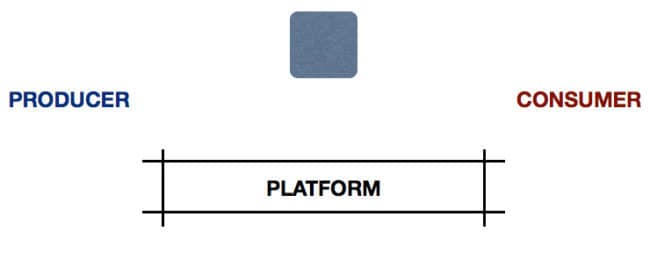
There are two key changes that happen as we move from pipes to platforms.
- The value creation shifts frominsidethe Pipe tooutsidethe Platform.
- The producer role shifts frominsidethe Pipe tooutsidethe Platform
These are the two fundamental shifts captured in all the talk about Open Innovation. And these are the two fundamental shifts we need to be aware of while designing platforms.
In the below video, I explain this topic during a masterclass at the MIT Media Labs in 2015
So let’s start designing platforms.
What is the core value unit?
The core value unit is the minimum standalone unit of value that is created on top of the platform. It represents supply or inventory created on top of the platform. Without this supply, the platform has very little value in and of itself. A platform may have more than one form of value unit. In such cases, the platform may have to be designed, keeping each form separately in mind.
Platform design starts with the core value unit.
The concept of the core value unit is best understood by looking at various examples of platforms. A marketplace like eBay has no value without the product listings on the marketplace. These listings are required to power interactions. Similarly, Instagram will cease to be valuable without a constant stream of selfies and pictures. Airbnb needs to have apartments available on the platform to deliver value.

What is the core interaction?
The core interaction is a set of actions that producers and consumers engage in repeatedly to derive value from the platform. The platform needs to repeatedly enable these interactions to ensure value creation and exchange.
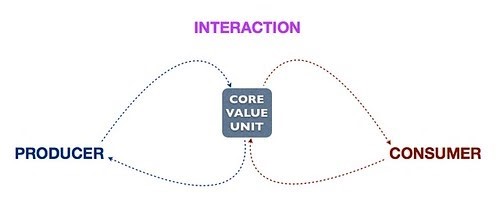
Creator uploads a video, Consumer, watches it, votes upon it. This is the core interaction of YouTube.
Creator starts a project, Consumer consumes it, backs it, etc. The core interaction on Kickstarter.
Each platform has a core interaction, which is a series of actions repeatedly taken by the producers and consumers of the platform to obtain value from the platform. YouTube relies on the uploading, viewing, and voting of videos. It works as an engine where all three actions are required. If any of these breaks down, the platform may fail to continue creating and delivering value in the manner that it currently does.
Wikipedia’s platform may seem complex, but it may be broken down into a set of actions involving the start of a new article stub, the creation and editing of content, the reversal and resolution of edits, and the consumption of content.
The goal of the platform is to enable the core interaction between producers and consumers.
In all interactions, the producer creates value for the consumer and the consumer “pays” for it using some form of currency. Currencies may range from actual money to attention, reputation, influence, and even data. For instance, video viewers on YouTube “pay” for videos through attention (views), reputation (votes), and influence (channel subscriptions).
A platform may have multiple value units and multiple interactions, but there will specifically be one that is core to the value proposition of the platform. Users do not use YouTube primarily to create and consume comments; they use it to create and consume videos. Commenting may serve as an edge interaction on YouTube and doesn’t centrally dictate the design of the platform.
All platform design decisions must ensure the repeatability and sustainability of the core interaction supported by the platform.
To understand the core interaction better, have a look at this lesson from the Platform Institute Enterprise masterclass
The core interaction sets up a framework for evaluating every feature or functionality that one may want to implement. The prioritization of features and functionalities, as well as community management and marketing initiatives, should be determined based on their ability to make the core interaction more efficient and repeatable.
A platform must enable all four actions – creation, curation, customization, and consumption – in order to enable value creation and exchange sustainably.
The core interaction connects individual user actions with the overall purpose of the platform.
What are the components of platform design?
Finally, we come to the platform components . Once you know the Core Value Unit and design the interaction as a set of actions, platform design is a lot simpler.
There are three key platform components: a mechanism to pull producers and consumers, an infrastructure and governance model that facilitates their interactions, and a matchmaking facility and learning capability that matches producers and consumers in value-creating interactions and learns from their activity on the platform. The goal of the platform is to facilitate these value-creating interactions and constantly scale its ability to perform all three functions described above.
In an HBR article on this topic, I explain these three key components of platform design as follows:
- Create pull that attracts participants to the platform. For transaction platforms, both producers and consumers must be present to achieve critical mass. Apple needed to attract both developers and users. Similarly, eBay needed both buyers and sellers. Platform builders must pay attention to the design of incentives, reputation systems, and pricing models. They must also leverage social media to harness the network effect for rapid growth.
- Create connection by making it easy for others to plug into the platform. This infrastructure enables interactions between participants. For example, Apple provides developers with the OS and underlying code libraries; YouTube provides hosting infrastructure to creators; Wikipedia provides writers with the tools to collaborate on an article.
- Create the flow of value by making connections between producers and consumers. Data is at the heart of successful matchmaking, and distinguishes platforms from other business models. The Matchmaker captures rich data about the participants and leverages that data to facilitate connections between producers and consumers. For example, Google matches the supply and demand of online content, while marketplaces like eBay match buyers to relevant products.
Overall, the key point here is that platform design should start with the value unit, flesh out the interaction and then design the platform as a consequence. Not the other way round. Let’s quickly recap our approach so far on platform design:
- Platform design should start with defining the value that is created or consumed, the Core Value Unit.
- The Core Value Unit should lead to the actions that enable the creation and consumption of that value.
- Only in the last step should one go about designing the platform that enables those actions.
What are the features of platforms? – Common Misconceptions
When building platforms, companies often make a common mistake. They start by looking at other existing platform businesses that have been successful and try to build out similar features. The problem with this feature thinking approach is that a platform business does not work like a software business. In a software business, value is created through the computations in the software. On a platform business, value is created through the activity of the ecosystem. Hence, the best technological components can prove insufficient if users don’t come on board the platform.
As I note in my book Platform Scale (Section 2 is devoted to the topic of Platform Design)
We are not in the business of building software! We are in the business of enabling interactions!
To design a platform, we need to start with understanding value creation on the platform. This brings us to the first critical priority while running a platform business: Focus on the core interaction and make it efficient and repeatable.
As a result, there are no stock feature sets for platforms. Good platform design starts with the best practice of designing the core interaction and then identifying the features and functionalities required to support the actions in the core interaction.
Platforms that shift the design process from a technology-first to an interaction-first approach will win.
Platform design should start with defining the value that is created or consumed, the Core Value Unit. The Core Value Unit should lead to the actions that enable the creation and consumption of that value. Only in the last step should one go about designing the system and interfaces that enable those actions.
Feel Free to Share
Download
Our Insights Pack!
- Get more insights into how companies apply platform strategies
- Get early access to implementation criteria
- Get the latest on macro trends and practical frameworks
What are the different types of platforms?
There are two broad platform types with vastly different design elements.
The first, aggregator platforms, aggregate consumers by providing consumer-facing services, and leverage their control over consumer relationships (and data) to orchestrate interactions with producers. Aggregator platforms act as gatekeepers of market access for producers looking to interact with consumers.
Aggregator platforms work as ecosystem orchestrators and perform four key functions: provisioning of consumer services, managing consumer data insights, on boarding and curation of producers, and matchmaking between producers and consumers. A key managerial concern in managing aggregator platforms involves managing openness to third party producers while maximizing relevance of matches and minimizing transaction risk.
Platforms like Airbnb, Facebook, Google (Search), and Amazon Marketplace are examples of aggregator platforms.
The second, infrastructure platforms, provide core production infrastructure, standards, information services, and data assets to inform, coordinate, and support production activities that firms engage in. Infrastructure platforms coordinate the activities of ecosystem firms across a core production process, towards a common production output.
Infrastructure platforms act as ecosystem shapers and perform three specific functions: they formulate a view of the emerging ecosystem, specify standards and data models (often embedded in their infrastructure) that organize and support participants’ activities, and signal their commitment to long-term ecosystem development by committing resources and engaging in open standards development.
In the construction industry, the Autodesk Construction Cloud is an infrastructure platform that coordinates designers and builders across the construction lifecycle, by providing a common infrastructure and a shared data model of the building. In the shipping industry, Maersk’s TradeLens infrastructure platform enables greater coordination across industry stakeholders, by integrating data across them to create a unified data model of the shipping lifecycle.
Read More: Platform Stack
What is the role of platform APIs?
An API is a programmable interface to access platform functionality.
APIs serve platforms externally by allowing managed and controlled access.Internally, APIs can be used to connect services or applications and control access to data or services resulting in an extremely clear and clean system architecture.
These technical interfaces standardize access to an organization’s assets (data and services). APIs lead to a liberation of access to data and services. In the coming years, every organization will need to have an API strategy and allow access to assets via APIs, just like every organization has a website strategy today to allow access to its information.
With platform design, one must distinguish between the system and the interfaces. YouTube is a complex system but has many different interfaces/functionalities for creators, viewers, brands, advertisers, media houses, programmers etc. on different channels.
The design of the interfaces should be true to the design of the system. And that is achieved when one starts by focusing on the value unit and the interactions it enables.
How can extensibility of a platform benefit a business?
Extensibility of a platform creates the potential for a multitude of new use cases built on top of the platform, or mashed-up with other platforms. Think of it as LEGOs on steroids, where the blocks are not only able to connect and build on top of each other but can also talk to each other and benefit from each other.
To achieve this goal of extendibility, platforms need to be accessed via some form of technical interface referred to as application programming interfaces (APIs). The better these APIs are designed and documented, the more effectively the platform infrastructure can be accessed and leveraged. This argument aligns with the external perspective mentioned above.
Because of that, it can be“customized by outside developers—users—and in that way, adapted to innumerable needs and niches that the original developers of the platform could not have imagined.”
Read more: APIs and Platforms: How interfaces and access enable the networked economy
How do I start a platform business? – Minimum viable platform
The design of a platform should start with the core value unit. It should then determine the producer and consumer with reference to the unit. Finally, it should lay out the actions that are performed in the core interaction. The platform’s role is to ensure the performance of these actions.
The core interaction is the repeatable formula for value creation and exchange on the platform.
A focus on the core interaction helps us define the requirements for a minimum viable platform. Unlike single-user products, platforms must cater to multiple user roles. The core interaction defines the minimum unit of value creation and exchange that caters to the key roles on the platform. The minimum viable platform should ensure that it designs all four actions in the core interaction sufficiently to enable the end-to-end interaction.
In the Lean Startup methodology, one often begins product development by validating a set of hypotheses sequentially. Every iteration of the platform may validate a hypothesis related to one of the four actions, but it is important to ensure that all other actions are also designed into the platform. Without designing the entire interaction, it may be counterproductive to try to test a hypothesis related to an individual action.
When implementing large platform projects, teams should ensure that they plan the roadmap in a way that progressively enhances the repeatability and efficiency of the core interaction. Features, functionalities, and initiatives that do not directly affect the core interaction, especially in the early days of the platform, may distract the team from more important execution.
Eventually, to build a multi-sided platform, you must expand beyond the core interaction, as I explain below in my masterclass at the MIT Platform Strategy Summit.
Platform Design – Methodology
Our platform design methodology involves the following key steps:
- Develop a detailed business architecture and strategy to build network effects and create a self-scaling, self-learning platform business.
- Identify key control points that ensure the central hub position of your platform in the ecosystem, while managing openness to third parties.
- Develop a detailed roadmap across multiple execution tracks to minimize execution risk and maximize network effects at each stage.
- Identify key success factors and risks at every stage and design metrics and stage-gating criteria to guide execution.
- Power charge your platform with our launch design to solve the chicken and egg problem and build network effects.
- Architect governance mechanisms to manage ecosystem activity, create trust, and manage access and decision rights for platform participants

Over the past decade, we have advised more than 40 of the Fortune 500 firms and a host of high growth startups on platform design. Our platform design approach includes strategies to build network effects and identify control points for your platform business.
Learn More About the Platform Design Services
Platform design – Masterclass
What is a platform strategy? How do you design a platform?
Learn more about platform design and how a platform works in our online masterclass on platform design – The Platform Institute.
While we lay out the basics of platform design on this explainer page, our platform design masterclass lays out a carefully curated step by step methodology to build out platform models, structure network effects, identify key control points, and design powerful monetization mechanisms and partner governance models.
Learn More about Platform Institute
Platform design – Program
Go beyond the masterclass and immerse yourself in our Platform Design program. Our cohort-based deep-dive program is a multi-week, immersive program that takes participants through a comprehensive approach to platform design, leveraging interactive, case-based discussions, strategy sprints, and Q&A sessions, combined with the best of our masterclass curriculum.

State of the Platform Revolution
The State of the Platform Revolution report covers the key themes in the platform economy in the aftermath of the Covid-19 pandemic.
This annual report, based on Sangeet’s international best-selling book Platform Revolution, highlights the key themes shaping the future of value creation and power structures in the platform economy.
Themes covered in this report have been presented at multiple Fortune 500 board meetings, C-level conclaves, international summits, and policy roundtables.
Subscribe to Our Newsletter




